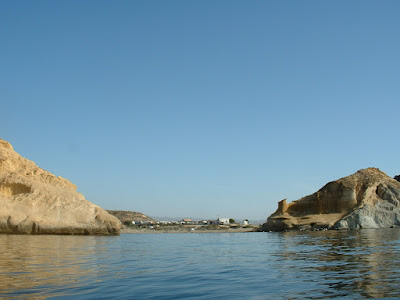Yesterday (Sunday November 27th.) I went back to Punta Parda, last visited a month ago (blog post 9/11/22), with The Twist. A shopping trip to Mojacar the previous day, with a look at the sea, had confirmed that after a long period of high winds conditions were looking pretty good for another kayak trip.
After launching in the lovely sheltered bay, Cala Cerrada, I paddled out into open water and round to Cala Taray to have a closer look at the cave rooms I saw on my previous visit. Of the three groups of man-made caves at Punta Parda this one is best reached by water.A view of the interior from the entrance. From the opening on the left the floor slopes up to a hole in ground above. The arched alcove looks like a fireplace but there isn't a chimney nor any sign of smoke deposits. There is a near identical alcove at the back, past the dividing wall. Ceiling is low, standing room for short people only!
Outside the cave is this shallow lagoon. It transpires that these cave rooms were not storerooms for fishermen, as I first thought. but were used for storing esparto grass. Part of processing of esparto grass, for its use in paper making, was soaking it in sea water - hence the creation of a shallow lagoon.
Heading back towards Punta Parda.

Time on the water was 2¼ hrs. and distance paddled was 6.7 kilometres - fueled by fig rolls, wine gums and a small carton of a tropical fruits drink. There were a few people on the beach in the bay when I got back there at 1:15 p.m. but nowhere near as many as when I was there a month ago. Colder days have arrived.
After packing the kayak away I went to look at the cave storerooms in the bay, which can be reached by foot.
The doorways to these rooms are too high above beach level to scramble into and some are gated.
Very close too these storerooms was the remains of another of the man-made shallow lagoons. According to a bit of Google research these 'lagoons' were called 'cocedores'.
According to the little we've found out so far about esparto grass, these cave storerooms date back to the 19th. century when the esparto grass trade was very important in this region of Spain. Esparto was used to make rope, twine, baskets, mats, soles for shoes and all manner of everyday items. It was even exported, in huge quantities, to England for the manufacture of quality paper - but it had to be damp ('fermenting' it said) before loading onto ships.
It had been an interesting, enjoyable and eventful kayaking day.




















